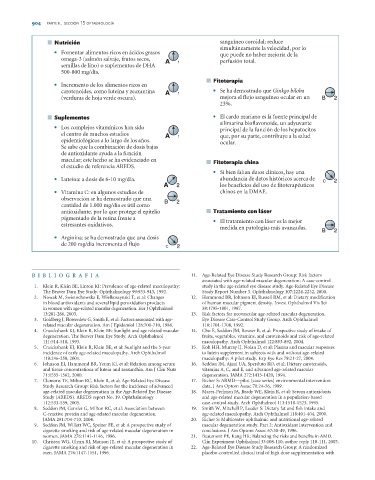Page 883 - medicina-integrativa_compress
P. 883
904 PARTE II, SECCIÓN 15 OFTALMOLOGÍA
■ Nutrición sanguíneo coroidal; reduce
simultáneamente la velocidad, por lo
• Fomentar alimentos ricos en ácidos grasos
que puede no haber mejoría de la
omega-3 (salmón salvaje, frutos secos, A A 1 perfusión total.
semillas de lino) o suplementos de DHA
500-800 mg/día.
■ Fitoterapia
• Incremento de los alimentos ricos en
carotenoides, como luteína y zeaxantina A A 1 • Se ha demostrado que Ginkgo biloba
(verduras de hoja verde oscura). mejora el flujo sanguíneo ocular en un B B 2 2
23%.
■ Suplementos • El cardo mariano es la fuente principal de
silimarina bioflavonoide, un adyuvante
• Los complejos vitamínicos han sido
principal de la función de los hepatocitos
el centro de muchos estudios A A 1 que, por su parte, contribuye a la salud
epidemiológicos a lo largo de los años. ocular.
Se sabe que la combinación de dosis bajas
de antioxidante ayuda a la función
macular; este hecho se ha evidenciado en ■ Fitoterapia china
el estudio de referencia AREDS.
• Si bien faltan datos clínicos, hay una
• Luteína: a dosis de 6-10 mg/día. abundancia de datos históricos acerca de
C 2 2
A A 2 2 los beneficios del uso de fitoterapéuticos
• Vitamina C: en algunos estudios de chinos en la DMAE.
observación se ha demostrado que una B B 2 2
cantidad de 1.000 mg/día es útil como
antioxidante, por lo que protege el epitelio ■ Tratamiento con láser
pigmentado de la retina frente a
• El tratamiento con láser es la mejor
estresantes oxidativos.
medida en patologías más avanzadas.
B B 2 2
• Arginina: se ha demostrado que una dosis
de 200 mg/día incrementa el flujo
C 2 2
BIBLIOGRAFIA 11. Age-Related Eye Disease Study Research Group: Risk factors
associated with age-related macular degeneration: A case-control
1. Klein R, Klein BE, Linton KI: Prevalence of age-related maculopathy: study in the age-related eye disease study. Age-Related Eye Disease
The Beaver Dam Eye Study. Ophthalmology 99:933-943, 1992. Study Report Number 3. Ophthalmology 107:2224-2232, 2000.
2. Nowak M, Swietochowska E, Wielkoszynski T, et al: Changes 12. Hammond BR, Johnson EJ, Russell RM, et al: Dietary modification
in blood antioxidants and several lipid peroxidation products of human macular pigment density. Invest Ophthalmol Vis Sci
in women with age-related macular degeneration. Eur J Ophthalmol 38:1795-1801, 1997.
13:281-286, 2003. 13. Risk factors for neovascular age-related macular degeneration.
3. Goldberg J, Flowerdew G, Smith E, et al: Factors associated with age- Eye Disease Case-Control Study Group. Arch Ophthalmol
related macular degeneration. Am J Epidemiol 128:700-710, 1988. 110:1701-1708, 1992.
4. Cruickshank KJ, Klein R, Klein BE: Sunlight and age related macular 14. Cho E, Seddon JM, Rosner B, et al: Prospective study of intake of
degeneration. The Beaver Dam Eye Study. Arch Ophthalmol fruits, vegetables, vitamins, and carotenoids and risk of age-related
111:514-518, 1993. maculopathy. Arch Ophthalmol 122:883-892, 2004.
5. Cruickshank KJ, Klein R, Klein BE, et al: Sunlight and the 5-year 15. Koh HH, Murray IJ, Nolan D, et al: Plasma and macular responses
incidence of early age-related maculopathy. Arch Ophthalmol to lutein supplement in subjects with and without age-related
119:246-250, 2001. maculopathy: A pilot study. Exp Eye Res 79:21-27, 2004.
6. Johnson EJ, Hammond BR, Yeum KJ, et al: Relation among serum 16. Seddon JM, Ajani UA, Sperduto RD, et al: Dietary carotenoids,
and tissue concentrations of lutein and zeaxanthin. Am J Clin Nutr vitamins A, C, and E, and advanced age-related macular
71:1555-1562, 2000. degeneration. JAMA 272:1413-1420, 1994.
7. Clemons TE, Milton RC, Klein R, et al; Age-Related Eye Disease 17. Richer S: ARMD—pilot (case series) environmental intervention
Study Research Group: Risk factors for the incidence of advanced data. J Am Optom Assoc 70:24-36, 1999.
age-related macular degeneration in the Age-Related Eye Disease 18. Mares-Perlman JA, Brady WE, Klein R, et al: Serum antioxidants
Study (AREDS). AREDS report No. 19. Ophthalmology and age-related macular degeneration in a population-based
112:533-539, 2005. case-control study. Arch Ophthalmol 113:1518-1523, 1995.
8. Seddon JM, Gensler G, Milton RC, et al: Association between 19. Smith W, Mitchell P, Leeder S: Dietary fat and fish intake and
C-reactive protein and age-related macular degeneration. age-related maculopathy. Arch Ophthalmol 118:401-404, 2000.
JAMA 291:704-710, 2004. 20. Richer S: Multicenter ophthalmic and nutritional age-related
9. Seddon JM, Willett WC, Speizer FE, et al: A prospective study of macular degeneration study. Part 2: Antioxidant intervention and
cigarette smoking and risk of age-related macular degeneration in conclusions. J Am Optom Assoc 67:30-49, 1996.
women. JAMA 276:1141-1146, 1996. 21. Beaumont PE, Kang HK: Balancing the risks and benefits in AMD.
10. Christen WG, Glynn RJ, Manson JE, et al: A prospective study of Clin Experiment Ophthalmol 33:108-110; author reply 110-111, 2005.
cigarette smoking and risk of age-related macular degeneration in 22. Age-Related Eye Disease Study Research Group: A randomized
men. JAMA 276:1147-1151, 1996. placebo-controlled clinical trial of high dose supplementation with

